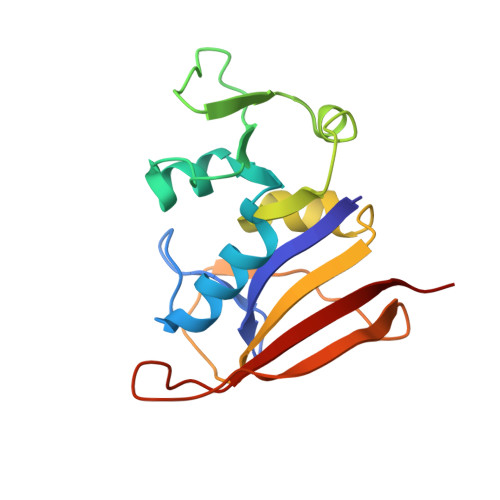Increased hydrophobic interactions of iclaprim with Staphylococcus aureus dihydrofolate reductase are responsible for the increase in affinity and antibacterial activity
Oefner, C., Bandera, M., Haldimann, A., Laue, H., Schulz, H., Mukhija, S., Parisi, S., Weiss, L., Lociuro, S., Dale, G.E.(2009) J Antimicrob Chemother 63: 687-698
- PubMed: 19211577
- DOI: https://doi.org/10.1093/jac/dkp024
- Primary Citation of Related Structures:
3FRA, 3FRB, 3FRD, 3FRE, 3FRF - PubMed Abstract:
Iclaprim is a novel 2,4-diaminopyrimidine that exhibits potent, rapid bactericidal activity against major Gram-positive pathogens, including methicillin-susceptible Staphylococcus aureus and methicillin-resistant S. aureus, and is currently in clinical development for the treatment of complicated skin and skin structure infections. An understanding of the known mechanism of resistance to trimethoprim led to the design of this new inhibitor, with improved affinity towards dihydrofolate reductase (DHFR) from S. aureus and clinically useful activity against S. aureus including isolates resistant to trimethoprim. The objective of this study was to characterize the mode of action of iclaprim and its inhibitory properties against DHFR. The mode of action of iclaprim was assessed by enzymatic analysis, direct binding studies, macromolecular synthesis profiles, synergy and antagonism studies to define its role as an inhibitor of DHFR. The binding properties of iclaprim to DHFR were compared with those of trimethoprim by X-ray crystallography. The enzymatic properties, direct binding and X-ray crystallographic studies delineated the mode of interaction with DHFR and the reason for the increased affinity of iclaprim towards the enzyme. The effect of iclaprim on bacterial physiology suggests that iclaprim behaves as a classical antibacterial DHFR inhibitor, as previously documented for trimethoprim. Iclaprim binds and inhibits bacterial DHFR in a similar manner to trimethoprim. However, the increased hydrophobic interactions between iclaprim and DHFR account for increased affinity and, unlike trimethoprim, enable iclaprim to inhibit even the resistant enzyme with nanomolar affinity, thus overcoming the mechanism of trimethoprim resistance. The increased antibacterial activity and lower propensity for resistance make iclaprim a clinically promising and useful inhibitor.
Organizational Affiliation:
Arpida AG, Duggingerstrasse 23, CH-4153 Reinach, Switzerland.
















